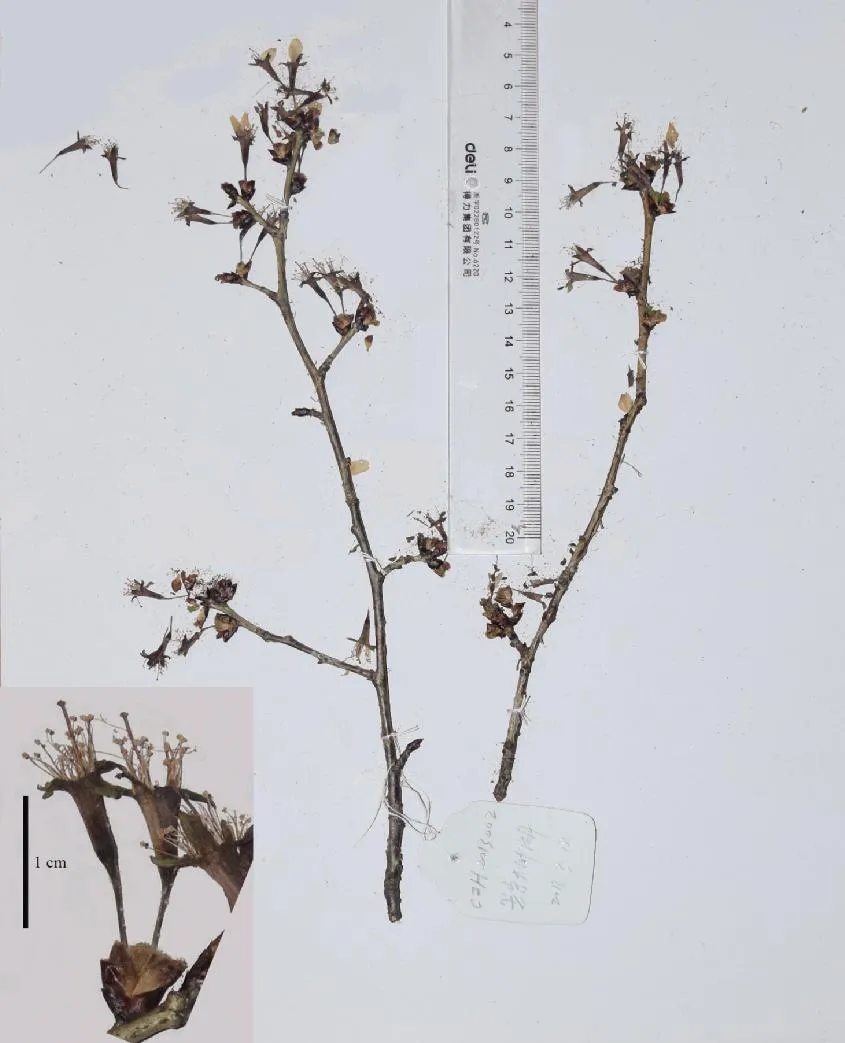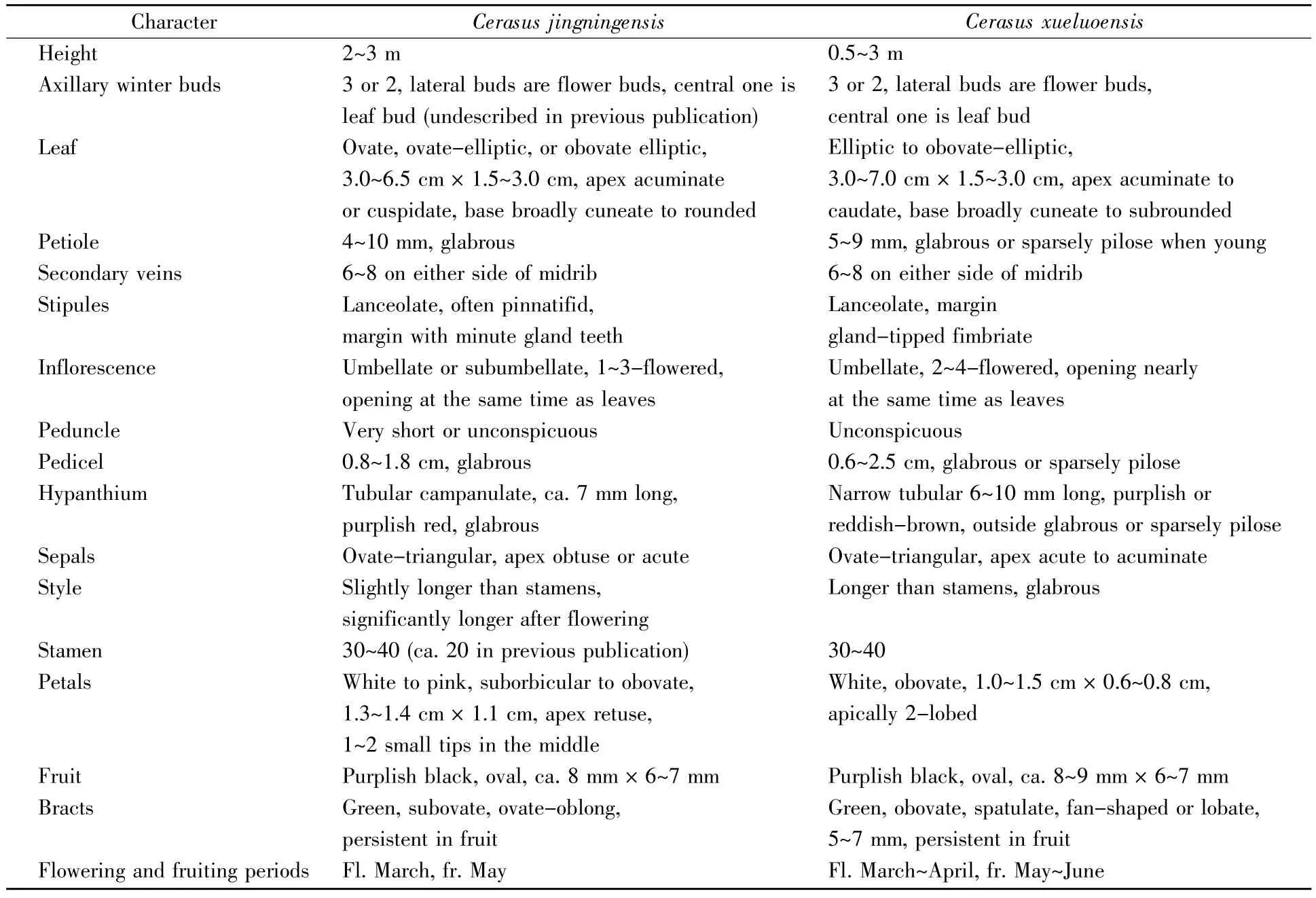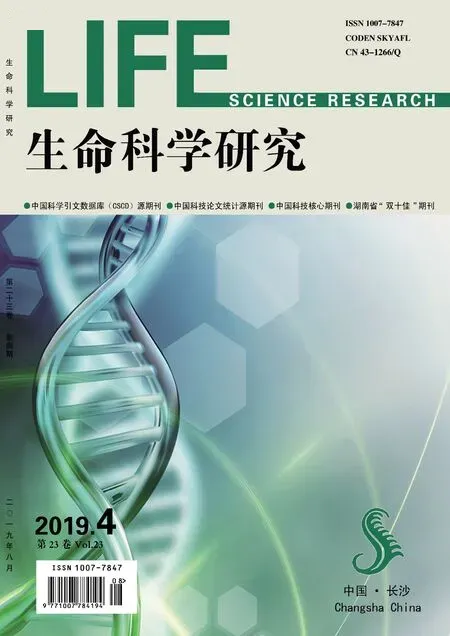Neotypification and New Synonym of Prunus jingningensis,comb.nov.
WU Yu,LIU Ying-di,ZHANG Dai-gui(.Hunan Province Key Laboratory of Crop Sterile Germplasm Resource Innovation and Application,College of Life Sciences,Hunan Normal University,Changsha 4008,Hunan,China;2.College of Biology and Environmental Sciences,Jishou University,Jishou 46000,Hunan,China)
Abstract:Herein,variation pattern was analyzed based on descriptions in literatures and specimens between Cerasus jingningensis and Cerasus xueluoensis.A neotype is designated for Cerasus jingningensis and then Cerasus xueluoensis is reduced to Prunus jingningensis(Z.H.Chen,G.Y.Li et Y.K.Xu)D.G.Zhang&Y.Wu,comb.nov.The taxonomic treatment and the neotype proposed in this paper are made in compliance with the rules and recommendations of the 2018 International Code of Nomenclature for Algae,Fungi,and Plants(Shenzhen Code).
Key words:Prunus;Cerasus;synonym;new combination;neotype
The genus Prunus Linnaeus sensu lato(s.l.)consists of over 200 species of deciduous and evergreen trees or shrubs,including commercially important cultivars such as cherry,plum and apricot[1].Its mem-bers are widely distributed both in the temperate zone of the northern hemisphere and in the subtropical and tropical forests of Asia,Africa,South America and Australia[1].The Prunus s.l.has sometimes been split apart into several genera:Amygdalus,Armeniaca,Cerasus,Laurocerasus,Padus and Prunus sensu stricto[2~4].However,recent studies in Prunus s.l.based on molecular phylogenetic analysis showed that it forms a monophyletic group while Cerasus,Laurocerasus and Padus are not monophyletic and the relationship among these genera sensu stricto are mixed[2~4],and therefore Prunus s.l.is accepted by scholars.
Xu et al.(2012)[5]described a species known from Jingning She Autonomous County,Zhejiang Province,as Cerasus jingningensis Z.H.Chen,G.Y.Li et Y.K.Xu.For its dwarf trees,tubular hypanthium and narrow leaf,it differs from similar species according to morphological features.When searching the herbaria(ZJFC)for its type specimen,the results showed this specimen had been lost.By Articles 9.7 and 9.16 of the International Code of Nomenclature for Algae,Fungi,and Plants(Shenzhen Code)[6],a neotype is designated for this name in the present paper.Nan et al.(2013)described that a new species,Cerasus xueluoensis C.H.Nan&X.R.Wang,had 3 axillary winter buds and narrow tubular hypanthia[7~8].However,according to PrinciplesⅢ of the Shenzhen Code,it should be reduced to Prunus jingningensis(Z.H.Chen,G.Y.Li et Y.K.Xu)D.G.Zhang&Y.Wu,comb.nov.
1 Materials and methods
Variation pattern was analyzed based on description in literatures and specimens.We examined specimens in herbarium of Zhejiang Agricultural&Forestry University(ZJFC),Central South U-niversity of Forestry&Technology(CSFI),Jishou U-niversity(JIU)and Chinese Virtual Herbarium(http://www.cvh.ac.cn),and collected fresh materials from Hunan(Liuyang,Yongshun,Longshan),Hubei(Wufeng),Zhejiang(Hangzhou).Morphological observations and measurements of leaves,flowers and fruits were randomly made.
2 Results
2.1 Neotype for Cerasus jingningensis
Cerasus jingningensis Z.H.Chen,G.Y.Li et Y.K.Xu in Jour.of Zhejiang For.Sci.&Tech.32(4):82-83(2012).Type:CHINA.Zhejiang,Jingning She Autonomous County,22 May 2012,Yuan-ke Xu,Chang-gao Zhao et al.JN1205001(holotype,ZJFC,lost);the same locality,18 March 2013,Zheng-hai Chen 2013002(neotype,ZJFC,designated here).
The neotype specimen(Fig.1)was collected from the type locality by one of the leading authors of Cerasus jingningensis.It is supplemented that two characters were ignored or incorrectly described in the previous publication:1)This species is a member of Prunus section Microcerasus(dwarf cherry)that have three axillary winter buds and dwarf trees;2)The number of stamens is 30~40 not ca.20,which can be affected by the development degree of stamens because short stamens are obscured by tubular hypanthia.
2.2 Variation pattern analysis

Fig.1 Neotype from type locality of Cerasus jingningensis(Zheng-Hai Chen 2013002)

Table 1 Morphological comparison
After careful examination of herbarium specimens and extensive field investigation,we considered Cerasus xueluoensis’variation patterns cover Cerasus jingningensis’and the former should be reduced to Cerasus jingningensis.Additionally,we proposed a new combination of Prunus jingningensis(Z.H.Chen,G.Y.Li et Y.K.Xu)D.G.Zhang&Y.Wu based on recent phylogenetic study.
Cerasus xueluoensis shares many stable and significant characters with Cerasus jingningensis such as dwarf trees,with 3 or 2 axillary winter buds and tubular hypanthia(Table 1).
2.3 New combination and new synonym
Prunus jingningensis(Z.H.Chen,G.Y.Li et Y.K.Xu)D.G.Zhang&Y.Wu,comb.nov.Type:CHINA.Zhejiang,Jingning She Autonomous County,18 March 2013,Zheng-hai Chen 2013002(neotype,ZJFC).
Basionym:Cerasus jingningensis Z.H.Chen,G.Y.Li et Y.K.Xu(2012:81)
Cerasus xueluoensis C.H.Nan&X.R.Wang(2013:79).≡Prunus xueluoensis(C.H.Nan&X.R.Wang)Y.H.Tong&N.H.Xia,syn.nov.Type:CHINA.Hubei,Enshi Tujia and Miao Autonomous Prefecture,Xuanen County,Mt.Xueluozhai,3 April 2009,Cheng-hui Nan 040301(holotype,NF).
Distribution and habitat:Prunus jingningensis is a widely distributed species and currently known from Zhejiang,Jiangxi,Hubei,Hunan,Guizhou(Songtao).It mostly grows in alpine shrubbery,alpine wetland and sparse pine forests at altitudes from 1 000 m to 1 500 m.
Additionalspecimensexamined:CHINA.Guizhou,Songtao,3 June 1988,Wulingshan Exploration Team 401(PE).Zhejiang,Jingning,18 March 2013,Zheng-hai Chen 2013003(ZJFC).Hubei,Hefeng,20 May 1959,Fu-song Peng 728(PE).Hunan,Yongshun,11 June 1988,Beijing Exploration Team 1495(PE);Pingjiang,5 April 2016,Xun-lin Yu et al.16040517(CSFI);Xingshao,7 May 2016,Jan-jun Zhou 16050702(CSFI).Jiangxi,Lushan,15 May 1977,Chou-fen Liang 34456(IBK).
Acknowledgements
Thanks Prof.Guo-hua Xia for helping inquire the specimen in ZJFC.

